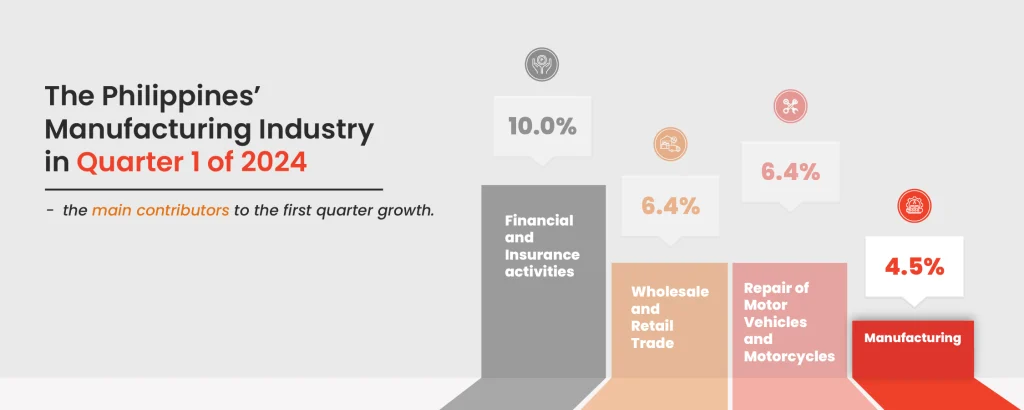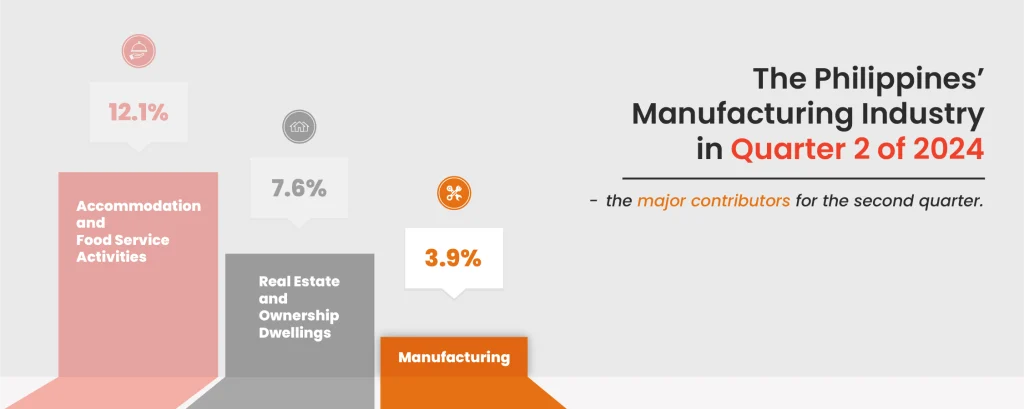SUMMARY: The Philippines’ manufacturing industry records its best-ever Purchasing Manager’s Index (PMI) in the last seven (7) years at 54.3. Thanks to product diversification and new client acquisitions, reported S&P Global Market Intelligence.
But despite ending the previous year on a high note, the Philippines’ manufacturing index slows down in the first month of the new year, recording a 3.68% decrease from December.
“To Be a Manufacturing Powerhouse” Dream Remains Alive for the Philippines
From being on the retreats since the 1980s to experiencing a resurgence in recent years, the Philippines keeps its dream of being a manufacturing powerhouse.
In December 2024, key manufacturing sectors like electronics, food, and chemicals continued to grow. This helped the country earn the highest Purchasing Managers’ Index (PMI) score in Southeast Asia, according to a report by S&P Global.
The year ended with a PMI of 54.3, showing stronger manufacturing activity in the Philippines compared to its neighboring countries.
President Marcos Pitches the Philippines as a Hub for Sustainable Manufacturing
At the ASEAN Business and Investment Summit in Laos, President Marcos promoted the Philippines as a key center for smart and sustainable manufacturing in Southeast Asia.
He highlighted the steady growth of the country’s manufacturing sector, noting the continued rise in the Purchasing Managers’ Index (PMI) despite global economic challenges.
In his speech, he urged foreign investors to explore opportunities in industries such as green metals, battery manufacturing, energy equipment, and agribusiness.
Quarterly Performance Summary of the Philippines’ Manufacturing Industry in 2024
Philippines’ Manufacturing Industry in Quarter 1 of 2024
In the first quarter of the year, the Philippines’ Gross Domestic Product (GDP) grew by 5.7% compared to the same period last year.
According to a report by the Philippine Statistics Authority, the main contributors to the first quarter growth were Financial and Insurance activities, Wholesale and retail trade, Repair of Motor Vehicles and Motorcycles, and Manufacturing.

Key subsectors that contribute to the manufacturing industry’s notable growth rate include food products, computer and electronic products, chemicals, and petroleum products.
Of the five subsectors listed, food manufacturing was the most profitable and accounted for the highest share. However, in terms of trade, electronic products were the leading export goods from the Philippines.
More importantly, what identified the modest growth of the Philippines’ manufacturing industry during the first quarter of 2024 was its purchasing managers’ index (PMI) score.
What is the Purchasing Manager’s Index (PMI)?
The Purchasing Managers’ Index (PMI) is a monthly survey that tracks business conditions. It gathers data from purchasing managers on new orders, production, jobs, supplier deliveries, and inventory levels.
A PMI score above 50 signals economic growth, while a score below 50 points to a slowdown.
In the first quarter of 2024, the Philippines’ manufacturing sector posted an average PMI score of 50.93—indicating steady growth during the first three months of the year.
Philippines’ Manufacturing Industry in Quarter 2 of 2024
The PSA reported a 6.3%, which was then revised to 8.1%, YoY growth in the GDP for the second quarter, with major contributors being as follows:

During Q2, the PMI historical average was at 51.8, which again implies a positive economy for the country. The breakdown is as follows:

In case you’re wondering why the PSA made revisions to the reported GDP for Q2:
The Q2 2024 figures were updated based on the approved revision policy under PSA Board Resolution No. 1, Series of 2017-053. This ensures consistency with international standards for revising national accounts.
To see the signed resolution, click here.
Philippines’ Manufacturing Industry in Quarter 3 of 2024
S&P Global reported that the Filipino manufacturing sector ended the third quarter on a solid note. This was because of the “robust expansion in new orders” that supported greater purchasing activity.
The PMI held steady after July’s reading of 51.2, rising to 53.7 in September—the highest level since mid-2022. This increase signaled a solid improvement in the overall health of the country’s manufacturing sector.
Philippines’ Manufacturing Industry in Quarter 4 of 2024
By the last quarter of the year, the local manufacturing sector’s PMI averaged 53.9. This is broken down into the following composite scores: October at 53.7, November at 53.8, and December at 54.3.
During this period, manufacturers boosted production to meet expected demand. Post-production inventories also grew. However, supply chains faced pressure due to raw material shortages and port congestion.
Maryam Baluch, an economist at S&P Global Market Intelligence, said:
“…adverse weather conditions resulting from the recent typhoons hitting the country and rising inflationary pressures make a difficult environment for manufacturers. Nonetheless, firms remained optimistic about future output, with hopes that improved demand trends and the upcoming election year will provide a boost to the sector.”
Taken from ‘Stronger improvement in operating conditions in the Filipino manufacturing sector in November’ by S&P Global

‘Chemical Manufacturing’ Comes Out as a Major Contributor to Economic Growth
The chemical manufacturing sector is a cornerstone of the Philippine economy, ranking among the largest manufacturing sub-sectors in the country.
Its influence extends across a range of vital industries, including agriculture, automotive, cement, creative, construction, energy, health, and pharmaceuticals. As such, it plays a significant role in driving economic growth.
Globally, demand for chemicals continues to rise due to growing industrial activity. This trend has attracted steady foreign investment, boosting the sector’s stability and long-term growth potential.
PH Manufacturing Industry 2025: Slows Down in January, reported by S&P Global
Despite the upward trajectory displayed in the previous year, the latest survey from S&P Global revealed a slight slowdown in the manufacturing sector’s PMI score in January 2025. From last year’s high of 54.3, the first month of the year recorded a score of 52.3.
Regardless, new orders are reported to have kept coming in at a strong pace, with high customer demand and new customers helping boost sales.
Ultimately, this strong demand remains to be attributed to the steady output produced by the Philippines’ manufacturing industry.


